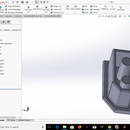Introduction: How to Make Your Servo Motor Do Full Rotation
What is a Servo Motor?
A servo motor is an electrical device which can push or rotate an object with great precision. If you want to rotate and object at some specific angles or distance, then you use servo motor. It is just made up of simple motor which run through servo mechanism. If motor is used is DC powered then it is called DC servo motor, and if it is AC powered motor then it is called AC servo motor. We can get a very high torque servo motor in a small and light weight packages. Doe to these features they are being used in many applications like toy car, RC helicopters and planes, Robotics, Machine etc. Servo Mechanism It consists of three parts:
Controlled deviceOutput sensorFeedback system
Step 1: Understanding the Basics of Servo Motor
Working principle of Servo Motors
A servo consists of a Motor (DC or AC), a potentiometer, gear assembly and a controlling circuit. First of all we use gear assembly to reduce RPM and to increase torque of motor. Say at initial position of servo motor shaft, the position of the potentiometer knob is such that there is no electrical signal generated at the output port of the potentiometer. Now an electrical signal is given to another input terminal of the error detector amplifier. Now difference between these two signals, one comes from potentiometer and another comes from other source, will be processed in feedback mechanism and output will be provided in term of error signal. This error signal acts as the input for motor and motor starts rotating. Now motor shaft is connected with potentiometer and as motor rotates so the potentiometer and it will generate a signal. So as the potentiometer’s angular position changes, its output feedback signal changes. After sometime the position of potentiometer reaches at a position that the output of potentiometer is same as external signal provided. At this condition, there will be no output signal from the amplifier to the motor input as there is no difference between external applied signal and the signal generated at potentiometer, and in this situation motor stops rotating.
Step 2: Now the Practical Part
As motor can be divided into 4 parts
- motor
- motor driver
- gear assembly
- potentiometer (POT)
first open the screw and carefully separate the gearbox ,
motor driver (that greenchip) have 3 input wires through which we operate it. 2 wires goes to motor , and rest 3(red) wire goes to POT (potentiometer) which give feedback to driver and tells the servo position ,
so here we hack the electronic and fake signal the driver motor that , servo is at initial position and remove the feedback system, so we do not need POT anymore
Step 3: Preparing the Motor Driver
desolder the POT wire, and carefully separate the pot.
now solder 2 resistor of 1k ohm in series ,
and solder at the place from where the pot is desolder , end terminals of series resistor at side pads of driver and the mid joint of series resistor at the middile pad of driver.
this will give fake feedback to driver as the position of shaft is always at initial point
now the driver is ready
Step 4: Preparing Shaft
As the pot itself work as a supporting shaft , so we will reuse it by just a mod.
pot can do only 180 degree rotation and a plate inside it will stop it for the further movement so we will remove that plate and make shaft of pot move full 360 degree in any direction.
with the help of tweezers remove that silver plate , and check the shaft now, that it should move full 360 degree.
Step 5: Gear Mod
the end servo gear have 2 stopper outgrowth ,cut it down so that it will not obstruct full rotation anymore.
now reassemble the motor again and you are done.
. with this test code , check the servo rotation.
----------------------------------------------------------------------------------------------in code
// Make servo go to 180 degrees
Servo1.write(180);
delay(1000); }
---------------------------------
in code by changing the degree you can change the motor direction
0 , 90 , 180.





